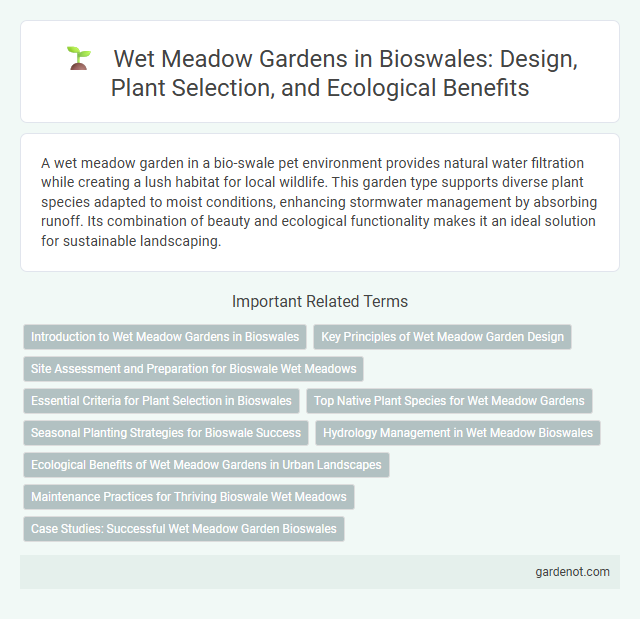A wet meadow garden in a bio-swale pet environment provides natural water filtration while creating a lush habitat for local wildlife. This garden type supports diverse plant species adapted to moist conditions, enhancing stormwater management by absorbing runoff. Its combination of beauty and ecological functionality makes it an ideal solution for sustainable landscaping.
Introduction to Wet Meadow Gardens in Bioswales
Wet meadow gardens in bioswales serve as natural filtration systems by using native grasses and wildflowers to absorb stormwater runoff, reducing pollutants before they enter waterways. These gardens mimic natural wetland ecosystems, promoting biodiversity and improving soil infiltration rates. Incorporating wet meadow plants enhances bioswale performance by stabilizing soil and supporting diverse wildlife habitats.
Key Principles of Wet Meadow Garden Design
Wet meadow garden design centers on hydrophilic plant selection, soil water retention, and natural water flow management to create a resilient ecosystem. Incorporating native grasses and sedges promotes biodiversity while ensuring efficient stormwater absorption and pollutant filtration. Strategic contouring and porous substrates enhance groundwater recharge and minimize surface runoff, supporting sustainable urban water cycles.
Site Assessment and Preparation for Bioswale Wet Meadows
Site assessment for bioswale wet meadows involves evaluating soil permeability, existing vegetation, hydrology, and microtopography to ensure optimal water infiltration and retention. Proper site preparation includes grading for appropriate slope, amending soil to enhance moisture retention, and removing invasive species to support native wet meadow plants. Establishing a stable soil base and creating conditions that mimic natural wetland hydrology are critical for bioswale performance and long-term ecological benefits.
Essential Criteria for Plant Selection in Bioswales
Wet meadow gardens in bioswales require plant species with high tolerance to both saturated soils and periodic dry conditions, ensuring resilience and effective stormwater management. Selecting native wetland plants such as Carex spp., Juncus effusus, and Lobelia cardinalis enhances filtration, erosion control, and habitat value. Essential criteria include deep root systems for soil stabilization, adaptability to fluctuating water levels, and ability to absorb and filter pollutants.
Top Native Plant Species for Wet Meadow Gardens
Top native plant species for wet meadow gardens include Carex stricta (tussock sedge), Asclepias incarnata (swamp milkweed), and Lobelia cardinalis (cardinal flower). These species thrive in saturated soils and support local biodiversity by providing habitat and nectar for pollinators like bees and butterflies. Incorporating native wet meadow plants enhances water filtration, reduces erosion, and promotes ecological balance in bio-swale systems.
Seasonal Planting Strategies for Bioswale Success
Wet meadow gardens in bioswales utilize seasonal planting strategies that optimize water absorption and pollutant filtration. Incorporating native grasses and perennials like blue flag iris, switchgrass, and swamp milkweed ensures year-round soil stabilization and habitat diversity. Timing plantings to match wet and dry cycles enhances nutrient uptake and supports resilient, sustainable bioswale ecosystems.
Hydrology Management in Wet Meadow Bioswales
Wet meadow bioswales enhance hydrology management by capturing and slowly infiltrating stormwater, reducing peak runoff and promoting groundwater recharge. These systems support a diverse plant community adapted to saturated soils, improving water retention and nutrient filtration. Effective design includes graded slopes and native vegetation to maximize water absorption and minimize erosion.
Ecological Benefits of Wet Meadow Gardens in Urban Landscapes
Wet meadow gardens in urban landscapes enhance biodiversity by providing habitats for native pollinators, amphibians, and bird species. These gardens improve water quality by filtering pollutants and reducing stormwater runoff, contributing to natural flood management. The diverse plant communities stabilize soil, promote groundwater recharge, and support carbon sequestration, fostering resilient urban ecosystems.
Maintenance Practices for Thriving Bioswale Wet Meadows
Maintaining a thriving bioswale wet meadow involves regular monitoring of hydrology to ensure consistent moisture levels and prevent waterlogging or drought stress. Periodic removal of invasive species and strategic planting of native wetland vegetation support biodiversity and improve pollutant filtration efficiency. Implementing seasonal mowing or controlled burns mimics natural disturbance regimes, promoting healthy plant growth and soil aeration.
Case Studies: Successful Wet Meadow Garden Bioswales
Case studies of successful wet meadow garden bioswales demonstrate their effectiveness in stormwater management by filtering pollutants and enhancing biodiversity. Notable projects, such as the Arlington County Wet Meadow Bioswale, have shown significant improvements in water quality and habitat creation by utilizing native wet meadow plants. These bioswales reduce runoff velocity, promote groundwater recharge, and support pollinators, validating their role as sustainable urban green infrastructure solutions.
Wet meadow garden Infographic

 gardenot.com
gardenot.com